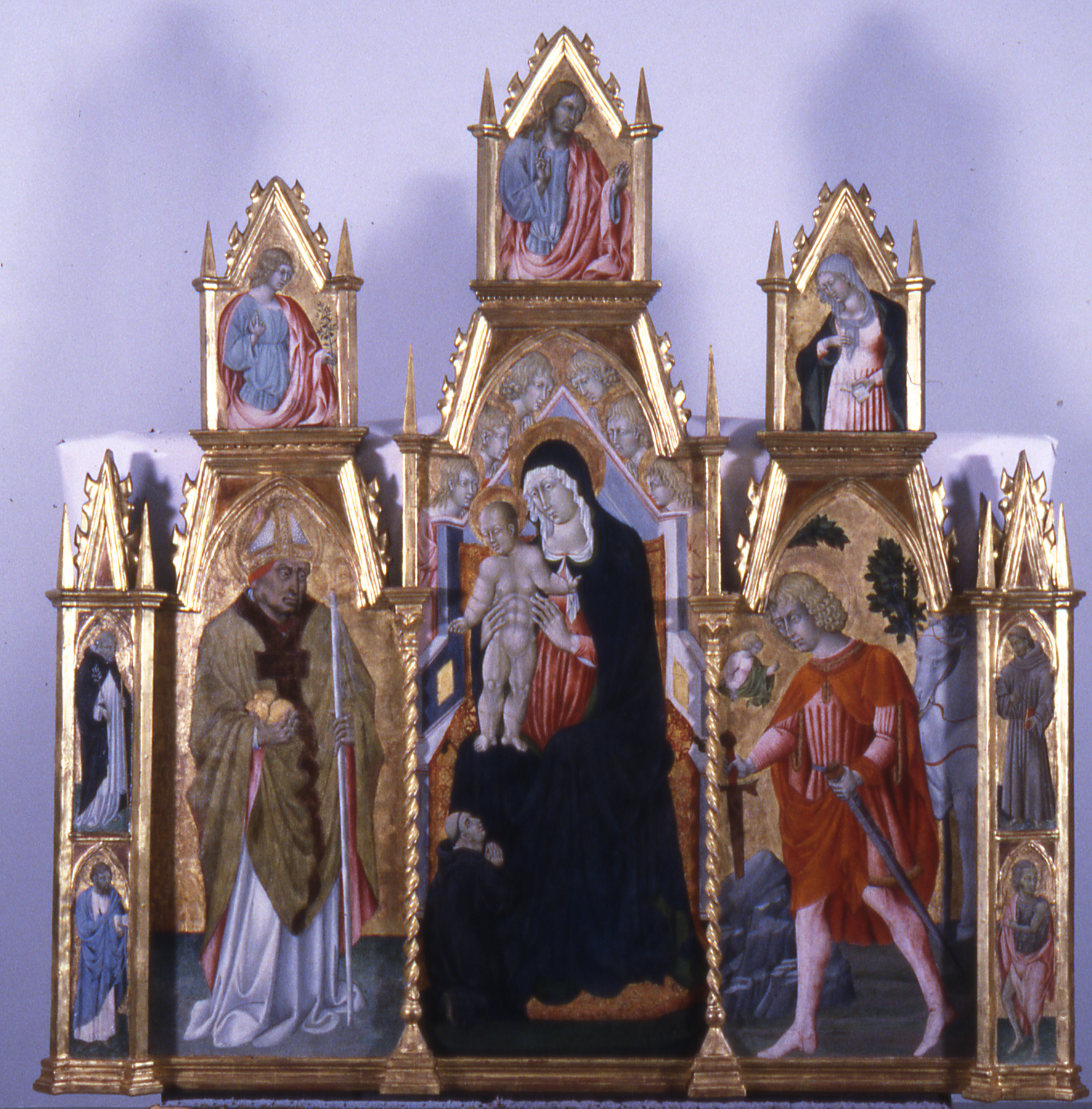Virgin and Child with Saints
(Renaissance Europe )
At the center of this multi-paneled altarpiece, the enthroned Virgin Mary, surrounded by angels, holds the Christ Child on her knee, allowing him to be worshipped by a kneeling monk, surely the individual who commissioned the painting. To the left of the central panel is the bishop saint Nicholas of Bari while to the right is Saint Galganus. Rarely depicted, Galganus is shown thrusting his sword into the rock on Mount Siepi (near Siena in Central Italy), where the Archangel Michael instructed him to build his hermitage. Flanking the side panels in the frame of the altarpiece are additional saints: at the left are Saints Dominic (above) and Bartholomew (below); at the right are Saints Francis of Assisi (above) and John the Baptist (below). The uppermost panels depict Christ as the blessing savior between the Archangel Gabriel (at the left) and the Virgin of the Annunciation (at the right).
Rejecting the naturalism of contemporary Florentine painting, Giovanni di Paolo worked in a style characterized by flat, linear forms and bright colors with a profusion of gold, reminiscent of the great traditions of earlier medieval painting. Such traditions were vigorously upheld in Giovanni's native Siena, carrying on the visual vocabulary of the city's artistic "Golden Age" in the 1300s.
Provenance
Provenance (from the French provenir, 'to come from/forth') is the chronology of the ownership, custody, or location of a historical object. Learn more about provenance at the Walters.
Compagnia del Santissimo Sacramento e Carità, Frosini [near Chiusdino, province of Siena]; Banca Popolare e Cassa di Risparmio, Genoa [date and mode of acquisition unknown]; Sale, Sangiorgi, Rome, April 8-11, 1895, lot 80 [as School of Pistoia, 15th century]; Private collection, Paris [date and mode of acquisition unkonwn]; B. Berenson, Settignano, 1911 [mode of acquisition unknown]; Henry Walters, Baltimore, 1911 [mode of acquisition unknown]; Walters Art Museum, 1931, by bequest.
Conservation
| Date | Description | Narrative |
|---|---|---|
| 1/1/1900 | Examination | chemical analysis |
| 1/1/1900 | Treatment | chemical analysis |
| 1/1/1900 | Treatment | chemical analysis |
| 1/1/1900 | Examination | examined for condition |
| 1/1/1935 | Treatment | chemical analysis |
| 9/8/1938 | Examination | chemical analysis |
| 10/1/1978 | Examination | chemical analysis |
| 4/26/1993 | Examination | chemical analysis; examined for condition |
| 4/26/1993 | Examination | chemical analysis |
| 10/20/1994 | Examination | chemical analysis; examined for condition |
| 1/1/1997 | Examination | examined for condition |
| 6/23/1997 | Examination | chemical analysis |
| 8/4/1997 | Examination | chemical analysis; examined for condition |
| 3/9/1999 | Examination | chemical analysis; examined for condition |
| 1/1/2008 | Examination | examined for condition |
Geographies
Italy, Siena (Place of Origin)
Measurements
H: 79 1/2 x W: 77 9/16 x Max. D: 1 3/4 in. (202 x 197 x 4.4 cm); Min. D: 1 1/2 in. (3.8 cm); Central panel painted surface H: 53 3/4 x W: 21 9/16 in. (136.5 x 54.7 cm); Left panel painted surface H: 42 5/16 x W: 18 7/8 in. (107.5 x 48 cm); Right panel painted surface H: 41 15/16 x W: 19 1/8 in. (106.5 x 48.5 cm); Central pinnacle painted surface H: 16 7/8 x W: 10 1/4 in. (42.8 x 26 cm); Left pinnacle painted surface H: 16 1/8 x W: 9 1/16 in. (41 x 23 cm); Right pinnacle painted surface H: 16 5/16 x W: 9 1/16 in. (41.5 x 23 cm)
Credit Line
Acquired by Henry Walters, 1911
Location in Museum
Accession Number
In libraries, galleries, museums, and archives, an accession number is a unique identifier assigned to each object in the collection.
In libraries, galleries, museums, and archives, an accession number is a unique identifier assigned to each object in the collection.
37.554




